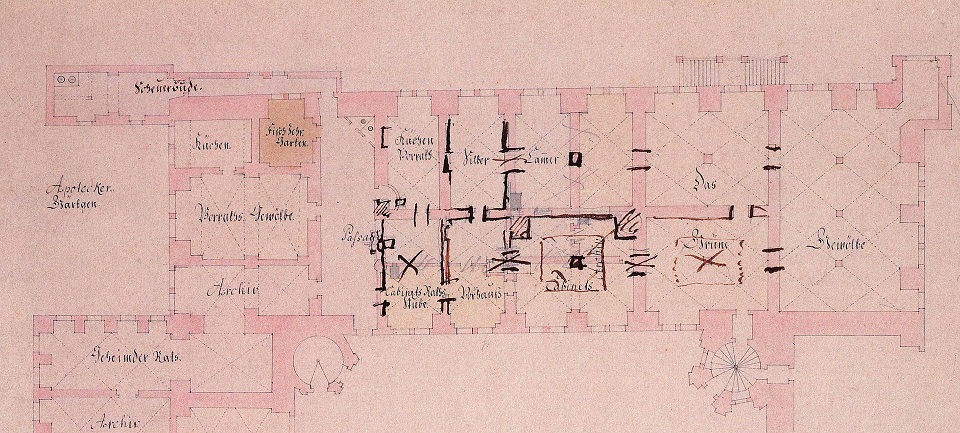Grüne Gewölbe

Description: The Grünes Gewölbe (English: Green Vault) in Dresden is a unique historic museum that contains the largest collection of treasures in Europe. Founded by Augustus the Strong in 1723, it features a rich variety of exhibits from the Baroque to Classicism. It is named after the formerly malachite green painted column bases and capitals of the initial rooms.
After the destruction of the Second World War, the Grünes Gewölbe has been completely reconstructed. Today, its treasures are shown in two exhibitions: The Historic Green Vault (Historisches Grünes Gewölbe) is famous for its splendors of the historic treasure chamber as it existed in 1733, while the New Green Vault (Neues Grünes Gewölbe) focuses the attention on each individual object in neutral rooms.
The Grünes Gewölbe is located on the first and second floors of the western section of the Dresden castle. It is now part of the Dresden State Art Collections.
History: The history of the "Green Vault" goes back to the year 1547, when elector Moritz of Saxony initiated the building of an additional west wing to the palace. Four of the new rooms on the first floor were given elaborate, molded plaster ceilings. The column bases and their capitals were painted with a characteristic bluish-green paint. Due to this color, the rooms were soon known as the "Green Vault", and the name has endured. The official name of the suite of rooms, which was protected against fire and robbery by thick walls, iron shutters and doors, was "Privy Repository" (Geheime Verwahrung).
Throughout the 17th century, these rooms were used by the rulers of Saxony as a private treasure chamber for important documents and jewelry.
Between 1723 and 1729, the elector Frederic Augustus I, today known as Augustus the Strong, turned the once private chambers into a public museum. First, he commanded splendid rooms to be created in which to display his collection. The Pretiosensaal (Hall of Treasures) and the Eckkabinett (Corner Cabinet) were listed as completed in the inventory of 1725; they reached their present-day form in this construction phase. An extension followed in 1727. Augustus’ intentions have been preserved on a ground plan from 1727 on which he drew his ideas. As in the first construction phase, the architect Matthäus Daniel Pöppelmann planned and built a museum-like, artistic structure of German Baroque grandeur. A suite of eight interconnecting rooms was constructed whose architectural beauty complemented the abundance and quality of the priceless treasures. Augustus the Strong could now exhibit his entire collection of valuables, including bronze statues and works of art in silver, gold, amber and ivory. The sequence of rooms was deliberately staged, presenting the objects according to their materials. By the end of his almost four-decade-long reign in 1733, Augustus the Strong had made his crown treasures and his inherited riches accessible to the public – an unprecedented innovation in the Baroque period.
These rooms remained unchanged for almost two centuries. When war was imminent in 1938, the art treasures were taken to the Königstein Fortress.
The Green Vault was severely damaged in the February 13, 1945 bombing of Dresden in World War II. Three of the eight rooms were totally destroyed. At the end of the war in 1945, the treasures were confiscated by the Red Army and transported to the Soviet Union. After their return to Dresden in 1958, part of the collection was displayed at the Albertinum.
In 2004, the Neues Grünes Gewölbe (New Green Vault) was opened on the second floor of the rebuilt Dresden castle. Its modern style of presentation centers on the works of art. In 2006, the reconstructed Historisches Grünes Gewölbe (Historic Green Vault) was reopened in the magnificent suite of rooms on the first floor as it had existed in 1733 at the time of its founder's death.
Arrangement: The whole collection consists of more than 4,000 pieces, with almost 1,100 in the New Green Vault and about 3,000 shown in the original Historic Green Vault.
The Historic Green Vault is located on the first floor of the Dresden Castle and the New Green Vault on the second floor, each covering approximately 2,000 square metres. The Historic Green Vault is famous for the splendors of the treasure chamber, in itself a baroque work of art, while the more modern New Green Vault focuses the attention on each individual object.
Entrance to the Historic Green Vault requires advance purchase of tickets for a specific entry time slot. A limited number of tickets is also sold every morning. The New Green Vault can be visited at any time.